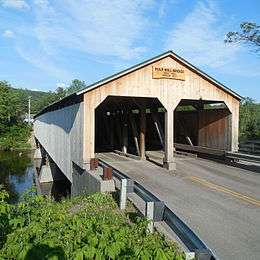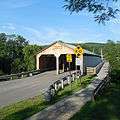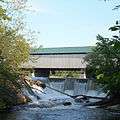Pulp Mill Covered Bridge
| Pulp Mill Covered Bridge | |
|---|---|
 Bridge in U.S. state of Vermont | |
| Carries | Automobile |
| Crosses | Otter Creek |
| Locale | Middlebury, Vermont |
| Maintained by | Towns of Middlebury and Weybridge |
| ID number | VT-01-04 |
| Characteristics | |
| Design | Covered, Burr arch |
| Material | Wood |
| Total length | 199 ft (60.66 m) |
| Width | 22.5 ft (6.86 m) |
| Number of spans | 3 |
| Clearance above | 8 ft (2.4 m) |
| History | |
| Constructed by | unknown |
| Construction end |
ca 1820 |
  | |
| Coordinates | 44°1′29″N 73°10′41″W / 44.02472°N 73.17806°WCoordinates: 44°1′29″N 73°10′41″W / 44.02472°N 73.17806°W |
| Area | 1 acre (0.4 ha) |
| NRHP Reference # | 74000200[1] |
| Added to NRHP | September 10, 1974 |
The Pulp Mill Covered Bridge, also called the Paper Mill Covered Bridge,[2] is a wooden covered bridge that crosses Otter Creek between Middlebury and Weybridge, Vermont on Seymour Street. It was listed on the National Register of Historic Places in 1974.[1]
History
The bridge is of Burr arch design. Around 1860, the original Burr arches were removed, and laminated ones added to King post trusses, changing the bridge type to a King post with Burr arch design. This bridge has many distinctions. It is one of only seven double-barreled (two lane) covered bridges in the country, one of only two in the State of Vermont (the Museum Covered Bridge being the other), and the only still carrying regular traffic. It is also the oldest covered bridge in Vermont, and one of the oldest in the country.
The exact age of the bridge is in question. A sign on the bridge states it was built between 1808 and 1820. Covered Bridge expert Jan Lewandosky has placed the year of construction at approximately 1850 based on his search of Minutes of the Selectboard of the Town of Middlebury, and his voluminous knowledge of covered bridge construction. In 1850 the Town of Middlebury sent a person to Essex, Vermont to examine a recently completed Burr Arch bridge, unfortunately the design was not copied correctly leading to the design flaws.
Improvements
The bridge was originally built as a single span but inherent design problems, and heavy use, has driven almost constant improvements. Amongst those improvements was the addition of two piers in the creek effectively dividing the bridge into 3 spans.[2] A non-structural improvement was the addition of a walkway on the outside of the bridge by the Towns of Weybridge and Middlebury. Several other rounds of repairs have been made and chronicled extensively at the Vermont Bridges website.[3]
The Pulp Mill bridge was closed from January 2, 2012[4] until November 9, 2012[5] for rehabilitation.
Photo Gallery
- View of Pulp Mill Bridge looking east from Weybridge in 2009; before the 2012 rehabilitation project
- Pulp Mill Bridge (looking east from Weybridge) during the rehabilitation project: Sep 2012
 Pulp Mill Bridge bicycle & pedestrian pathway, looking west from Middlebury, VT
Pulp Mill Bridge bicycle & pedestrian pathway, looking west from Middlebury, VT Pulp Mill Bridge (with bicycle & pedestrian way) looking east from Weybridge, VT: 13 Jun 2015
Pulp Mill Bridge (with bicycle & pedestrian way) looking east from Weybridge, VT: 13 Jun 2015 View of Pulp Mill Bridge from the north along Otter Creek: 13 Jun 2015
View of Pulp Mill Bridge from the north along Otter Creek: 13 Jun 2015
See also
- National Register of Historic Places listings in Addison County, Vermont
- List of Vermont covered bridges
- List of bridges on the National Register of Historic Places in Vermont
References
- 1 2 National Park Service (2010-07-09). "National Register Information System". National Register of Historic Places. National Park Service.
- 1 2 Evans, Benjamin and June. New England's Covered Bridges. University Press of New England, 2004. ISBN 1-58465-320-5
- ↑ Bridge News Archive. vermontbridges.com
- ↑ "Pulp Mill Bridge to close Jan. 2". Addison County Independent. 22 December 2011.
- ↑ "Vermont's oldest covered bridge reopens". Green Mountain Outlook. 12 November 2012.
External links
 Media related to Pulp Mill Bridge at Wikimedia Commons
Media related to Pulp Mill Bridge at Wikimedia Commons- Historic American Engineering Record (HAER) No. VT-31, "Pulp Mill Bridge, Seymour Street, Middlebury/Pulp Mill Bridge Road, Weybridge, spanning Otter Creek, Middlebury, Addison County, VT"